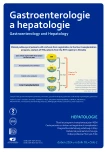Isoniazid induced liver injury associated with jaundice
Authors:
M. Sučík 1; R. Rosoľanka 1; L. Nosáková 2; D. Krkoška 1; K. Šimeková 1
Authors‘ workplace:
Klinika infektológie a cestovnej medicíny JLF UK a UN Martin 2 Interná klinika – gastroenterologická JLF UK a UN Martin
1
Published in:
Gastroent Hepatol 2024; 78(2): 156-164
Category:
Hepatology
doi:
https://doi.org/10.48095/ccgh2024156
Overview
Isoniazid belongs to the first line antituberculosis drugs and can be used for the treatment of both active and latent tuberculosis infections. It is a part of combined regimens, for the preventive treatment of tuberculosis isoniazid can be used in monotherapy as well. Even though elevations in serum aminotransferases levels during isoniazid therapy are seen frequently, the development of symptomatic hepatitis is rare, according to specialised literature. This article describes a case of a patient who developed drug-induced liver injury accompanied by jaundice during the isoniazid preventive treatment of tuberculosis. It also provides a summary of the currently known risk factors, pathogenesis, and incidence of hepatotoxicity observed throughout therapy with this antituberculosis drug. We also illustrate the process of diagnosing drug--induced liver injury in clinical practice settings with the utilisation of the updated RUCAM score.
Keywords:
jaundice – isoniazid – drug-induced liver injury – tuberculosis preventative therapy – updated RUCAM score.
Sources
1. Griffith DE, Philley JV, Wallace Jr RJ. Antimycobacterial Agents. In: Bennett JE, Dolin R, Blaser (eds). Mandell, Douglas, and Bennett’s principles and practice of infectious diseases. 9. vyd. Philadelphia: Elsevier 2020: 478–479.
2. Melnychuk L, Perlman-Arrow S, Lisboa Bastos M et al. A Systematic Review and Meta-Analysis of Tuberculous Preventative Therapy Adverse Events. Clinical Infectious Diseases 2023; 77 (2): 287–294. doi: 10.1093/cid/ciad246.
3. Tweed CD, Wills GH, Crook AM et al. Liver toxicity associated with tuberculosis chemotherapy in the REMoxTB study. BMC Med 2018; 16 (1): 46. doi: 10.1186/s12916-018-1033-7.
4. Centers for Disease Control and Prevention (CDC). Severe isoniazid-associated liver injuries among persons being treated for latent tuberculosis infection – United States, 2004–2008. MMWR Morb Mortal Wkly Rep 2010; 59 (8): 224–229. 2010 [online]. Dostupné z: https: //www.cdc.gov/mmwr/preview/mmwrhtml/mm5908 a3.htm.
5. Mindikoglu AL, Magder LS, Regev A. Outcome of liver transplantation for drug-induced acute liver failure in the United States: analysis of the United Network for Organ Sharing database. Liver Transpl 2009; 15 (7): 719–729. doi: 10.1002/lt.21692.
6. Lim WS, Avery A, Kon OM et al. Anti-tuberculosis drug-induced liver injury. BMJ 2023; 383: e074866. doi: 10.1136/bmj-2023-074 866.
7. Štátny ústav pre kontrolu liečiv (ŠÚKL). SPC_Nidrazid tbl_09.2021.pdf. 2021 [online]. Dostupné z: https: //www.sukl.sk/hlavna-stranka/slovenska-verzia/pomocne-stranky/detail-lieku?page_id=386&lie_id=03303.
8. Suk KT, Kim DJ. Drug-induced liver injury: present and future. Clin Mol Hepatol 2012; 18 (3): 249. doi: 10.3350/cmh.2012.18.3.249.
9. Šperl J, Červinková Z. Toxické poškození jater. In: Urbánek P, Brůha R (eds). Hepatologie 4. vyd. Praha: Grada Publishing 2022: 328–337.
10. Aithal GP, Watkins PB, Andrade RJ et al. Case Definition and Phenotype Standardization in Drug-Induced Liver Injury. Clin Pharmacol Ther 2011; 89 (6): 806–815. doi: 10.1038/clpt. 2011.58.
11. Hayashi PH, Fontana RJ, Chalasani NP et al. Under-reporting and Poor Adherence to Monitoring Guidelines for Severe Cases of Isoniazid Hepatotoxicity. Clin Gastroenterol Hepatol 2015; 13 (9): 1676.e1–82.e1. doi: 10.1016/ j.cgh.2015.02.024.
12. Danan G, Teschke R. RUCAM in Drug and Herb Induced Liver Injury: The Update. IJMS 2015; 17 (1): 14. doi: 10.3390/ijms17010 014.
13. Abbara A, Chitty S, Roe JK et al. Drug-induced liver injury from antituberculous treatment: a retrospective study from a large TB centre in the UK. BMC Infect Dis 2017; 17 (1): 231. doi.org/10.1186/s12879-017-2330-z.
14. Devarbhavi H. Adaptation and Antituberculosis Drug-induced Liver Injury. Am J Respir Crit Care Med 2012; 186 (4): 387–388. doi: 10.1164/ajrccm.186.4.387.
15. Saukkonen JJ, Cohn DL, Jasmer RM et al. An official ATS statement: hepatotoxicity of antituberculosis therapy. Am J Respir Crit Care Med 2006; 174 (8): 935–952. doi: 10.1164/rccm. 200510-1666ST.
16. Roussel Uclaf Causality Assessment Method (RUCAM) in Drug Induced Liver Injury. LiverTox: Clinical and Research Information on Drug-Induced Liver Injury. National Institute of Diabetes and Digestive and Kidney Diseases. 2012 [online]. Dostupné z: http: //www.ncbi.nlm.nih.gov/books/NBK548272/.
17. Nahid P, Dorman SE, Alipanah N et al. Executive Official American Thoracic Society/Centers for Disease Control and Prevention/Infectious Diseases Society of America Clinical Practice Guidelines: Treatment of Drug-Susceptible Tuberculosis. Clin Infect Dis 2016; 63 (7): 853–867. doi: 10.1093/cid/ciw 566.
18. Dhiman RK, Saraswat VA, Rajekar H et al. A guide to the management of tuberculosis in patients with chronic liver disease. J Clin Exp Hepatol 2012; 2 (3): 260–270. doi: 10.1016/ j.jceh.2012.07.007.
Zoznam použitých skratiek
ORCID autorov
M. Sučík 0009-0005-0300-6330,
R. Rosoľanka 0000-0003-0429-6833,
L. Nosáková 0000-0003-0432-8575.
Labels
Paediatric gastroenterology Gastroenterology and hepatology SurgeryArticle was published in
Gastroenterology and Hepatology

2024 Issue 2
Most read in this issue
- Diagnosis of alcohol liver disease by gastroenterologist
- Isoniazid induced liver injury associated with jaundice
- First experience with fi lgotinib in the upper line of treatment in patients with ulcerative colitis
- Liver transplantation for acute liver failure
